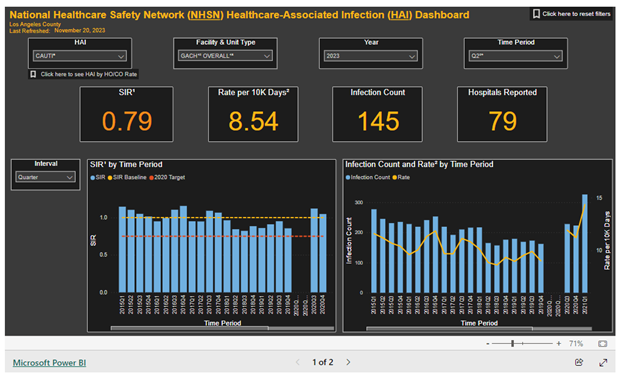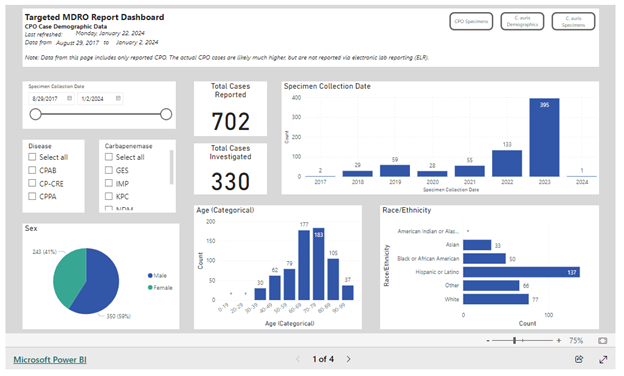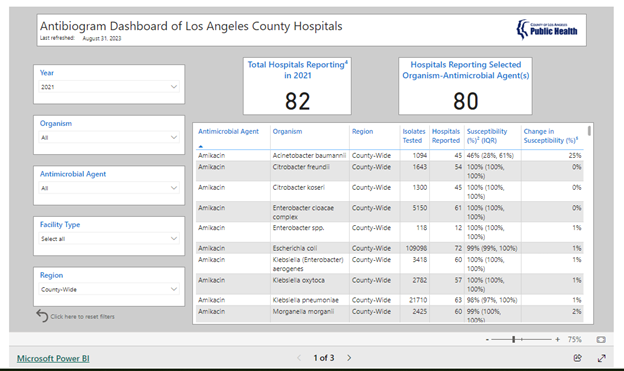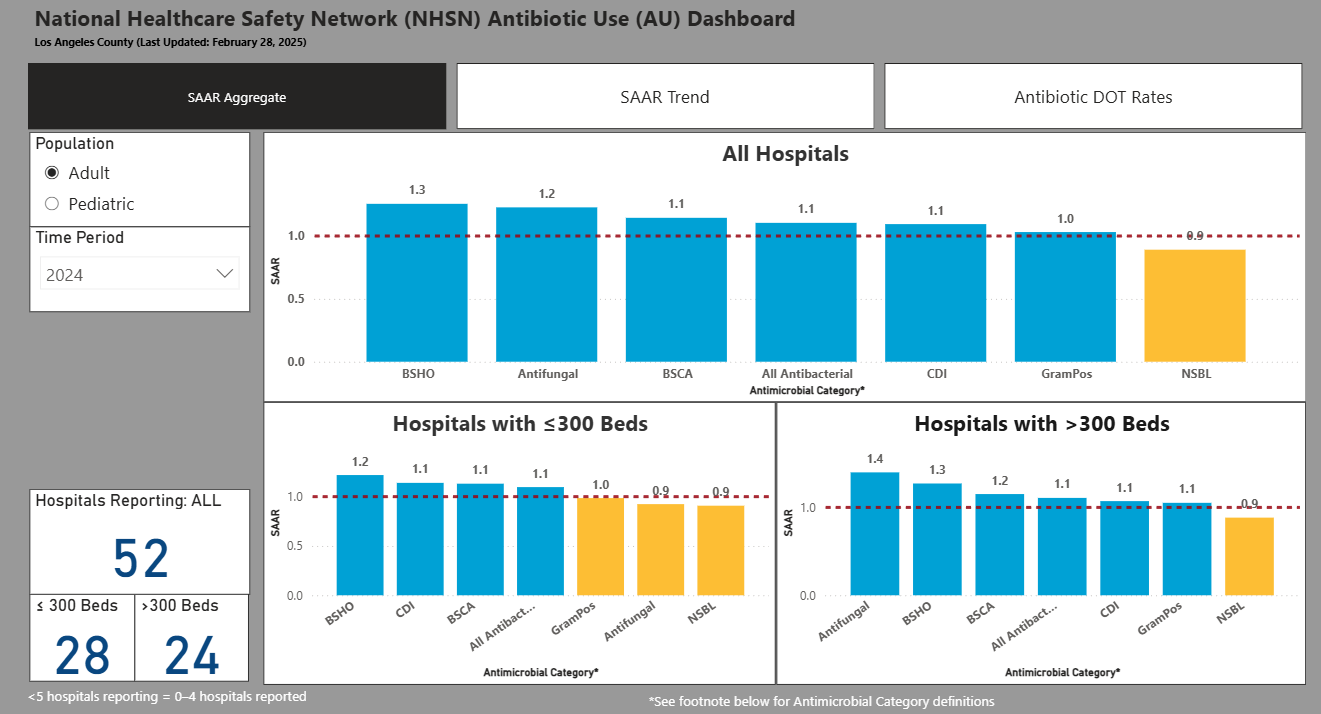Data Dashboards and Reports
Los Angeles County Hospital Healthcare-Associated Infections Dashboard
This interactive dashboard allows users to view healthcare-associated infection data reported by general acute care hospitals and long-term acute care hospitals in Los Angeles County. Data can be broken down by time period (quarter, half-year, year), facility type, and infection type. Users can view overall counts and rates, and view data visually. Data exist from 2015 to present. Healthcare facility users may use the dashboard to compare their facility rates to the aggregate county data.

Los Angeles County Targeted Multidrug-Resistant Organism (MDRO) Dashboard
This interactive dashboard contains data on select multidrug-resistant organisms in Los Angeles County residents. The selected organisms reflect those commonly attributed to healthcare-associated infections. Users can view counts by case demographics, organism species and resistance gene, and information about the healthcare facility where the organism was identified. The dashboard is split into two pages each on carbapenemase-producing organisms and Candida auris. Healthcare facility users may use this dashboard to understand the local MDRO epidemiology for risk assessments and other prevention activities. Data exist from 2017 to present.

Los Angeles County Hospital Antibiogram Dashboard
This interactive dashboard displays data reported by acute care hospitals in Los Angeles County on antibiotic susceptibilities of bacteria tested in the laboratory. Users may use this dashboard to track specific antibiotic resistance over time and by hospital type. Users may also use this dashboard to compare their facility’s antibiogram to the county aggregate data. Data exist from 2018 to present.

How to use the antibiogram data: The regional antibiogram may be beneficial to various stakeholders. It can be used as a benchmark 1 for local data to determine if, for example:
- local data contain outliers that may suggest errors within the data (e.g., penicillin resistance in beta-hemolytic streptococci)
- modifications to antimicrobial agents routinely tested in a facility should be considered
- investigations or interventions in infection prevention practices may be needed.
1Simner PJ, Hindler JA, Bhowmick T, Das S, Johnson JK, Lubers BV, Redell MA, Stelling J, Erdman SM. What's New in Antibiograms? Updating CLSI M39 Guidance with Current Trends. J Clin Microbiol. 2022 Oct 19;60(10):e0221021. doi: 10.1128/jcm.02210-21. Epub 2022 Aug 2. PMID: 35916520; PMCID: PMC9580356. https://pubmed.ncbi.nlm.nih.gov/35916520/
Los Angeles County Antibiotic Use Dashboard
This interactive dashboard presents countywide hospital antibiotic use data as reported to the National Healthcare Safety Network, including Standardized Antimicrobial Administration Ratios (SAARs) and Antimicrobial Days of Therapy (DOT) rates. Users can filter data by time period (quarterly or annually) starting from 2023. The dashboard allows users to view adult and pediatric SAAR categories aggregated by location, as well as trends over time for both SAARs and DOTs. These data provide insight into countywide antibiotic use patterns and can support antimicrobial stewardship efforts. Hospitals may use the information to compare their own antibiotic use to countywide trends.

Archives
Healthcare-Associated Infections Regional Summary Reports
- Los Angeles County Healthcare-Associated Infections 2019 Regional Summary Report
- Los Angeles County Healthcare-Associated Infections 2018 Regional Summary Report
- Los Angeles County Healthcare-Associated Infections 2017 Regional Summary Report
- Los Angeles County Healthcare-Associated Infections 2016 Regional Summary Report
- Los Angeles County Healthcare-Associated Infections 2015 Regional Summary Report
Multidrug-Resistant Organism Report
Antibiogram Reports
- 2020 Antibiogram Report
- 2020 Gram-Negative Bacteria Data Tables by Organism
- 2020 Gram-Positive Bacteria Data Tables by Organism
- 2017 Antibiogram Report
- 2015 Antibiogram Report
Special Reports
- The First Year of Mandated Carbapenem-resistant Enterobacteriaceae and Antibiogram Reporting in Los Angeles County: 2017
- Activating Vital Advances in Antimicrobial Resistance Testing among Los Angeles County Healthcare Facilities
- Using CDC’s Core Elements of Outpatient Stewardship to Improve Antibiotic Prescribing Practices in Los Angeles County
Contact Information
For further questions, please email us at hai@ph.lacounty.gov

